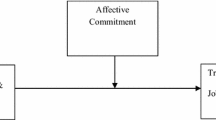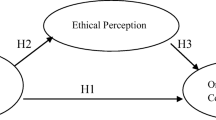Abstract
People seldom leave an organisation, but they often leave because of the people in that organisation. Given the current context of multinational organisations and virtual teams, it is imperative to ensure a vibrant and positive team climate for employees that helps them thrive and deliver excellence. It is well established in the literature that among other factors, employees’ interpersonal skills, emotional intelligence and cultural competence significantly impact team climate. This study focuses on analysing the relationship between emotional social competence (ESC) and perceived team climate. The study draws from the self-determination theory which states individuals are responsible and intrinsically motivated. The development of a positive team climate has been looked upon primarily as a collective initiative. While it is important to focus on organisational aspects contributing to team climate, this study explores the individual competencies that contribute to the perception of a positive team climate. It employs structural equation modelling technique to study this relationship through data from a field study with 331 managers from manufacturing, banking and service industries. Results confirm that ESC clusters have a significant impact on the perceived team climate of the individuals. The practical implications of the study show that the organisations need to formulate developmental plans around individual competencies that have significant impact on building a positive team climate.


Similar content being viewed by others
References
Anderson, J. C., & Gerbing, D. W. (1988). Structural equation modelling in practice: A review and recommended two-step approach. Psychological Bulletin, 103(3), 411.
Anderson, N., & West, M. A. (1996). The Team Climate Inventory: Development of the TCI and its applications in teambuilding for innovativeness. European Journal of work and organisational psychology, 5(1), 53–66.
Anderson, N. R., & West, M. A. (1998). Measuring climate for work group innovation: development and validation of the team climate inventory. Journal of Organisational Behaviour, 19(3), 235–258.
Antonakis, J., Ashkanasy, N. M., & Dasborough, M. T. (2009). Does leadership need emotional intelligence? The Leadership Quarterly, 20(2), 247–261.
Arbuckle, J. (2008). Amos 17.0 user’s guide. Chicago: SPSS Inc.
Ashforth, B. E. (1985). Climate formation: Issues and extensions. Academy of Management Review, 10(4), 837–847.
Bar-On (1988); In Bar-On, R. (2006). The Bar-On model of emotional-social intelligence (ESI). Psicothema, 18(Suplem. 1), 13–25.
Boyatzis, R. E. (1982). The competent manager: A model for effective performance. New York: Wiley.
Boyatzis, R. E. (2009). Competencies as a behavioural approach to emotional intelligence. Journal of Management Development, 28(9), 749–770.
Boyatzis, R. E., Goleman, D., & Rhee, K. (2000). Clustering competence in emotional intelligence: Insights from the Emotional Competence Inventory (ECI). Handbook of Emotional Intelligence, 99(6), 343–362.
Brooks, K., & Muyia Nafukho, F. (2006). Human resource development, social capital, emotional intelligence: Any link to productivity? Journal of European Industrial Training, 30(2), 117–128.
Brundin, E., & Nordqvist, M. (2008). Beyond facts and figures: The role of emotions in boardroom dynamics. Corporate Governance: An International Review, 16(4), 326–341.
Bunce, D., & West, M. A. (1995). Self-perceptions and perceptions of group climate as predictors of individual innovation at work. Applied Psychology, 44(3), 199–215.
Carlson, K. D., & Wu, J. (2012). The illusion of statistical control: Control variable practice in management research. Organizational Research Methods, 15(3), 413–435.
Carmeli, A. (2009). Chapter 3 Positive work relationships, vitality, and job performance. In Emotions in groups, organisations and cultures (pp. 45–71). Emerald Group Publishing Limited.
Cherniss, C. (2000). Social and emotional competence in the workplace. In R. Bar-On & J. D. A. Parker (Eds.), The handbook of emotional intelligence: Theory, development, assessment, and application at home, school, and in the workplace (pp. 433–458). San Francisco, CA: Jossey-Bass.
Cohen, S. G., & Bailey, D. E. (1997). What makes teams work: Group effectiveness research from the shop floor to the executive suite. Journal of Management, 23(3), 239–290.
Dahling, J. J., & Perez, L. A. (2010). Older worker, different actor? Linking age and emotional labour strategies. Personality and Individual Differences, 48(5), 574–578.
Deeter-Schmelz, D. R., & Sojka, J. Z. (2003). Developing effective salespeople: Exploring the link between emotional intelligence and sales performance. The International Journal of Organisational Analysis, 11(3), 211–220.
Druskat, V. U., & Wolff, S. B. (2001). Building the emotional intelligence of groups. Harvard Business Review, 79(3), 80–91.
Dutton, J. E. (2003). Energize your workplace: How to create and sustain high-quality connections at work. San Francisco, CA: Jossey-Bass.
Fornell, C., & Larcker, D. F. (1981). Evaluating structural equation models with unobservable variables and measurement error. Journal of Marketing Research, 18(1), 39–50.
Fredrickson, B. L. (2001). The role of positive emotions in positive psychology: The broaden-and-build theory of positive emotions. American Psychologist, 56(3), 218–226.
Goleman, D. (1995). Emotional intelligence: Why it can matter more than IQ for character, health and lifelong achievement. New York: Bantam Books.
Goleman, D. (1998). Working with emotional intelligence. New York: Bantam Books.
Goleman, D. (2000). An EI-based theory of performance. In D. Goleman, & C. Cherniss (Eds.), The emotionally intelligent workplace: How to select for, measure, and improve emotional intelligence in individuals, groups, and organizations (pp. 27–44). San Francisco, CA: Jossey-Bass.
Goleman, D., & Boyatzis, R. (2008). Social intelligence and the biology of leadership. Harvard Business Review, 86(9), 74–81.
Goleman, D., Boyatzis, R. E., & McKee, A. (2002). The New Leaders: Transforming the art of leadership into the science of results. London: Little, Brown.
Guillén Ramo, L., Saris, W. E., & Boyatzis, R. E. (2009). The impact of social and emotional competencies on effectiveness of Spanish executives. Journal of Management Development, 28(9), 771–793.
Herman, H. M., Dasborough, M. T., & Ashkanasy, N. M. (2008). A multi-level analysis of team climate and interpersonal exchange relationships at work. The Leadership Quarterly, 19(2), 195–211.
Hosking, D. M., & Anderson, N. (Eds.). (1992). Organisational change and innovation: Psychological perspectives and practices in Europe. London: Taylor and Francis, Routledge.
James, L. R., & Jones, A. P. (1974). Organizational climate: A review of theory and research. Psychological Bulletin, 81(12), 1096.
Jordan, P. J., & Ashkanasy, N. M. (2006). Emotional intelligence, emotional self-awareness, and team effectiveness. In Linking emotional intelligence and performance at work: Current research evidence with individuals and groups (pp. 145–163). New Jersey: Lawrence Erlbaum Associates.
Kivimaki, M., & Elovainio, M. (1999). A short version of the Team Climate Inventory: Development and psychometric properties. Journal of occupational and organisational psychology, 72(2), 241–246.
Koys, D. J., & DeCotiis, T. A. (1991). Inductive measures of psychological climate. Human Relations, 44(3), 265–285.
Kozlowski, S. W., & Ilgen, D. R. (2007). The science of team success. Scientific American Mind, 18(3), 54–61.
Lehmann, D. R. (1988). An alternative procedure for assessing convergent and discriminant validity. Applied Psychological Measurement, 12(4), 411–423.
Lewis, K. M. (2000). When leaders display emotion: How followers respond to negative emotional expression of male and female leaders. Journal of Organisational Behaviour, 21(2), 221–234.
Maslow, A. H. (1943). A theory of human motivation. Psychological Review, 50(4), 370.
McGrath, J. E. (1964). Social psychology: A brief introduction. New York: Holt, Rinehart and Winston.
Morgeson, F. P., Reider, M. H., & Campion, M. A. (2005). Selecting individuals in team settings: The importance of social skills, personality characteristics, and teamwork knowledge. Personnel Psychology, 58(3), 583–611.
Pakenham, Chiu, Burnsall, & Cannon. (2007). In, Spreitzer, G., Sutcliffe, K., Dutton, J. E., Sonenshein, S., & Grant, A. M. (2005). A socially embedded model of thriving at work. Organisation Science, 16(5), 537–549.
Petrides, K. V., & Furnham, A. (2000). On the dimensional structure of emotional intelligence. Personality and Individual Differences, 29(2), 313–320.
Pirola-Merlo, A., Härtel, C., Mann, L., & Hirst, G. (2002). How leaders influence the impact of affective events on team climate and performance in R&D teams. The leadership quarterly, 13(5), 561–581.
Plant, R. W., & Ryan, R. M. (1985). Intrinsic motivation and the effects of self-consciousness, self-awareness, and ego-involvement: An investigation of internally controlling styles. Journal of Personality, 53(3), 435–449.
Riggio, R. E., & Lee, J. (2007). Emotional and interpersonal competencies and leader development. Human Resource Management Review, 17(4), 418–426.
Rojell, E. J., Pettijohn, C. E., & Parker, R. S. (2006). Emotional intelligence and dispositional affectivity as predictors of performance in sales people. Journal of Marketing Theory and Practice, 14(2), 113–124.
Ryan, R. M., & Deci, E. L. (2000). Intrinsic and extrinsic motivations: Classic definitions and new directions. Contemporary Educational Psychology, 25(1), 54–67.
Ryan, R. M., & Deci, E. L. (2001). On happiness and human potentials: A review of research on hedonic and eudaimonic well-being. Annual Review of Psychology, 52(1), 141–166.
Salovey, P., & Mayer, J. D. (1990). Emotional intelligence. Imagination, Cognition and Personality, 9(3), 185–211.
Seers, A. (1989). Team-member exchange quality: A new construct for role-making research. Organisational behaviour and human decision processes, 43(1), 118–135.
Shraga, O., & Shirom, A. (2009). The construct validity of vigour and its antecedents: A qualitative study. Human Relations, 62(2), 271–291.
Spencer, L. M., Jr., & Spencer, S. M. (1993). Competence at work: Models for superior performance. New York: Wiley.
Strating, M. M., & Nieboer, A. P. (2009). Psychometric test of the Team Climate Inventory-short version investigated in Dutch quality improvement teams. BMC Health Services Research, 9(1), 126. https://doi.org/10.1186/1472-6963-9-126.
Stubbs Koman, E., & Wolff, S. B. (2008). Emotional intelligence competencies in the team and team leader: A multi-level examination of the impact of emotional intelligence on team performance. Journal of Management Development, 27(1), 55–75.
Thylefors, I., Persson, O., & Hellström, D. (2005). Team types, perceived efficiency and team climate in Swedish cross-professional teamwork. Journal of Interprofessional Care, 19(2), 102–114.
Author information
Authors and Affiliations
Corresponding author
Additional information
Publisher's Note
Springer Nature remains neutral with regard to jurisdictional claims in published maps and institutional affiliations.
Rights and permissions
About this article
Cite this article
Bhartia, A., Vijayalakshmi, V. Does Emotional Social Competence Foster Team Climate?. Psychol Stud 64, 83–91 (2019). https://doi.org/10.1007/s12646-019-00481-7
Received:
Accepted:
Published:
Issue Date:
DOI: https://doi.org/10.1007/s12646-019-00481-7




